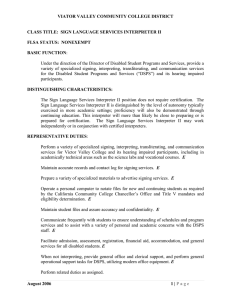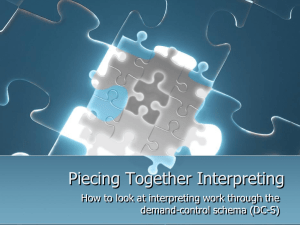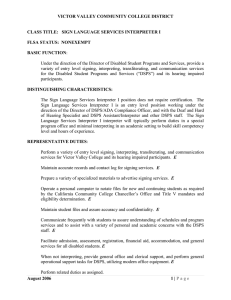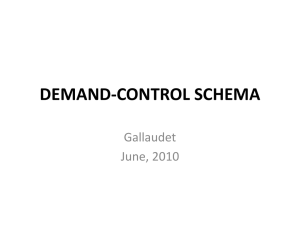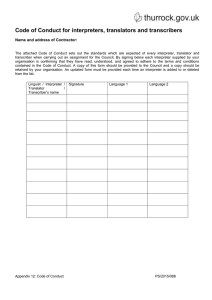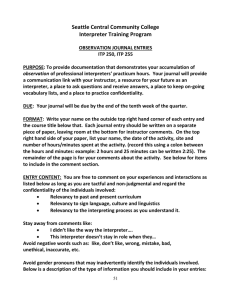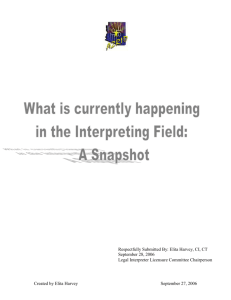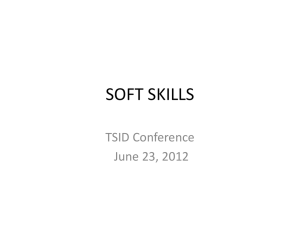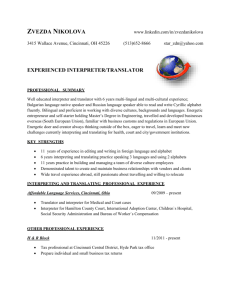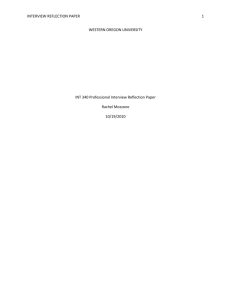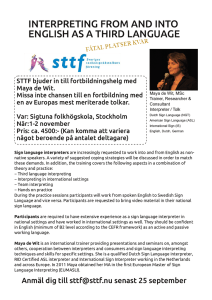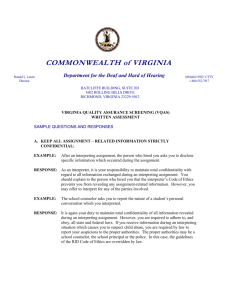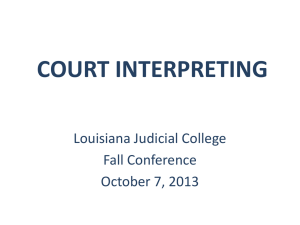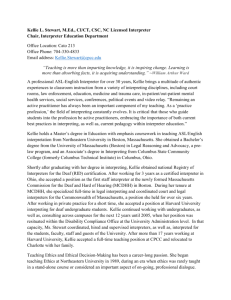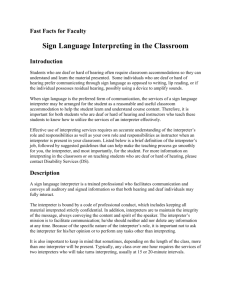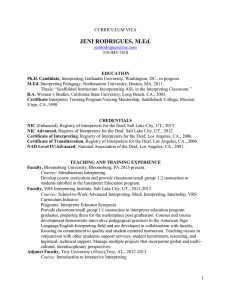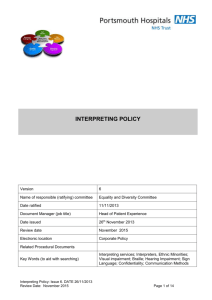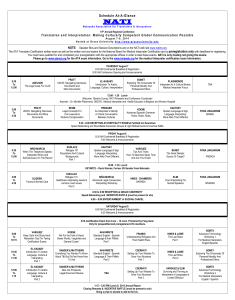Dean and Pollard`s Demand-Control Schema for Interpreting Work
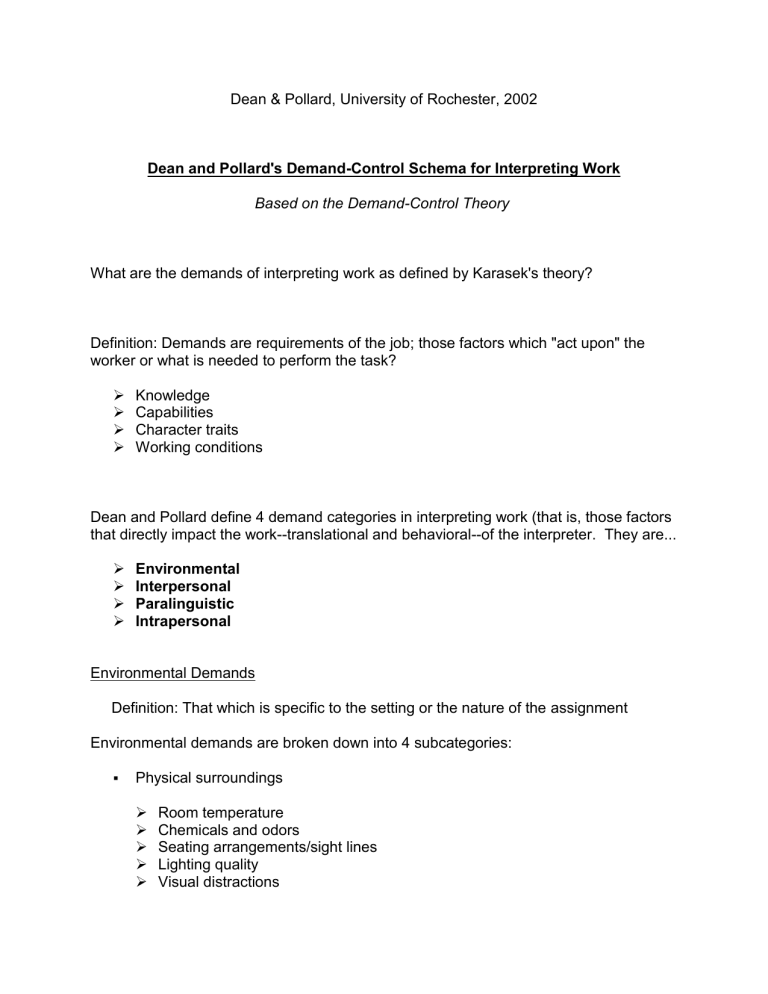
Dean & Pollard, University of Rochester, 2002
Dean and Pollard's Demand-Control Schema for Interpreting Work
Based on the Demand-Control Theory
What are the demands of interpreting work as defined by Karasek's theory?
Definition: Demands are requirements of the job; those factors which "act upon" the worker or what is needed to perform the task?
Knowledge
Capabilities
Character traits
Working conditions
Dean and Pollard define 4 demand categories in interpreting work (that is, those factors that directly impact the work--translational and behavioral--of the interpreter. They are...
Environmental
Interpersonal
Paralinguistic
Intrapersonal
Environmental Demands
Definition: That which is specific to the setting or the nature of the assignment
Environmental demands are broken down into 4 subcategories:
Physical surroundings
Room temperature
Chemicals and odors
Seating arrangements/sight lines
Lighting quality
Visual distractions
Background noise
Space (people, furniture, equipment)
Goal or purpose of setting
Terminology
Personnel or clientele
Questions one could ask to get at Environment Demands:
What is the nature of this place?
What are the physical surroundings like?
Who are the staff, personnel, or clientele here?
What is the objective here?
What kind of equipment is expected?
What is the expected terminology that is used here?
_____________________________________________________________________
Interpersonal Demand
Definition: That which is specific to the dynamics among the consumers and the interpreter
Interpersonal Demands (examples)
Dynamics between HC and DC o Oppression, dishonesty, unfairness, etc.
Dynamics between HC and I o Adherence to expected role norms o Communication directed to the interpreter
Dynamics between DC and I o Parties' understanding of interpreter's role
Power and authority dynamics
Communication control, e.g., turn-taking
Thought worlds (see quote below)
Emotional tone/mood
Roles
Communication styles and goals
Relationships (new, familiar, intimate, tension, power, etc)
Interpreting...is not merely transposing from one language to another. It is, rather, throwing a semantic bridge between two different cultures, two different thought worlds.
Claude Namy, 1977
Questions to ask about the Interpersonal interactions:
What is the emotional tone of the interaction?
What are the thought worlds of each party (SES to current emotional state?)?
What is the mood of the people involved?
What do they want to accomplish?
What is the nature of the relationship?
Is it positive or are there problems? Why?
How do they feel about me as the interpreter?
____________________________________________________________________
Paralinguistic Demands
Definition: That which is specific to the expressive skills of the deaf/hearing consumers
Examples of paralinguistic demands:
Idiosyncrasies of signing/speaking
Volume
Pace
Accents
Clarity of speech
Physical position
Physical limitations
Questions about paralinguistic demands:
What is the deaf person's signing style? o Fast/slow--smooth/choppy--precise/sloppy
What is the speaking style of the hearing person? o Loud/soft--accented, impediment
Is the language of both deaf/hearing people coherent and following typical patterns of speech and discourse?
Idiosyncrasies of signing/speaking
Clarity of Speech/Signing
What impacts one's clarity?
Age
Disabilities
-Cognitive and physical
Mood/emotional state
Physical attributes/characteristics
Fluid movement of signing
Physical Limitations
Intellectual disability
Stroke
Injured limb(s)
Intoxication
Arthritis
Other range of motion problems (R.O.M)
Cerebral Palsy
Facial paralysis
AD/HD
Neck problems
_____________________________________________________________________
Intrapersonal Demands
Definition: That which is specific to the feelings and thoughts or personal experiences of the interpreter
Examples of Intrapersonal Demands
Feelings or ruminations one may have about: o One's safety o o
One's interpreting performance
Liability o o
The people and the dynamics
The environment
Physiological distractions
_____________________________________________________________________
What are the controls employed in interpreting work as defined by Karasek's theory?
Controls are defined as skills or resources that the worker can bring to bear in response to the demands of the job.
Controls for an interpreter may involve:
Behavioral actions and interventions
Particular translation decisions
Internal/attitudinal acknowledgments
Dean & Pollard's D-C schema defines "controls" in three time phrases:
Pre-assignment controls: controls that are employed before or in preparation for the formal assignment
Examples:
Education o Formal (interpreter training and continuing ed.) o Informal (other schooling)
Experience o Work-related o Personal
Direct preparation for the assignment o Contacts (team, hearing and deaf consumers) o Readings, prep materials, Internet
Assignment controls: controls that are employed during the interpreting assignment
Examples:
Acknowledgments
Self-talk
Direct interventions
Adjusted translations
Prior relationships
RID Code of Ethics
Role metaphors
Post-assignment controls : controls that are employed after the assignment is over
Examples:
Supervision o Formal (with supervisor) o Informal (with colleagues)
Debriefing/venting o With support system
Follow up o With people involved o With further education o With referring party
Self-care
